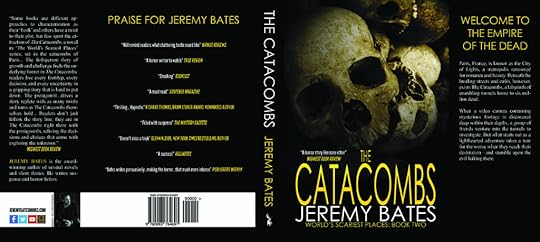Jeremy Bates's Blog: Latest News, page 5
December 5, 2015
Suicide Forest – Goodreads Choice Awards 2015 Finalist
 Wanted to say thanks to everyone who voted for Suicide Forest in the Goodreads Choice Awards 2015. It’s an honor to be in the company of the other authors on the shortlist.
Wanted to say thanks to everyone who voted for Suicide Forest in the Goodreads Choice Awards 2015. It’s an honor to be in the company of the other authors on the shortlist.
You can check out the horror category here:
https://www.goodreads.com/choiceawards/best-horror-books-2015
And a brief summary on CNN here:
http://edition.cnn.com/2015/12/01/living/goodreads-choice-awards-2015-feat/
November 9, 2015
The Catacombs – Now Available in Hardcover
March 15, 2015
Run – Giveaway
For the March 15th release of the novella RUN I’ll be giving away 10 copies to people, randomly chosen, who have added it to their to-read on Goodreads.
Cheers!
Jeremy
February 26, 2015
The Catacombs Giveaway
For the February 24 release of The Catacombs, I’ll be giving away 10 copies, randomly, to the first 10 people who add it to their Goodreads to-read list.
Cheers!
Jeremy
February 25, 2015
Suicide Forest Hardcover
Suicide Forest will be released in hardcover in March, 2015. There will be an accompanying giveaway on Goodreads. Good luck!
January 19, 2015
Black Canyon Launch
For the February 10 2015 launch of Black Canyon, I’ll be giving away ten copies of the novel to those who’ve entered it To-read on Goodreads. Winners will be chosen randomly. Cheers!
November 18, 2014
Suicide Forest Giveaway
To kick off the December release of Suicide Forest, I’ll be giving away a free digital copy to the first ten or so people who mark it as to-read on Goodreads. So if you have a Goodreads account, go for it! And I’ll be in touch.
February 5, 2014
White Lies – February Kindle Deal
White Lies has been selected as one of the monthly Kindle $3.99 and under for February! Oceanview’s marketing/publicity manager said he asked for it to be priced at $2.99.
So, if you’re looking for some winter reading, please check it out!
December 7, 2013
Dream Destination Blog-Hop
Thanks to Lexa and Julie for setting up this blog-hop! It’s pretty self-explanatory: where is your dream destination?
This is a tough call for me. I really like to travel, and there are so many places I want to go! But if I had to chose one for the next vacation, it would probably be Peru. The reason is twofold. I have never been to South America (SA and Africa are the last remaining continents I have to get to!). Also, I’ve always wanted to go to Machu Picchu.
And if you want some neat facts about the place, check out National Geographic’s Top 10 Machu Picchu Secrets:
1) It’s not actually the Lost City of the Inca.
When the explorer Hiram Bingham III encountered Machu Picchu in 1911, he was looking for a different city, known as Vilcabamba. This was a hidden capital to which the Inca had escaped after the Spanish conquistadors arrived in 1532. Over time it became famous as the legendary Lost City of the Inca. Bingham spent most of his life arguing that Machu Picchu and Vilcabamba were one and the same, a theory that wasn’t proved wrong until after his death in 1956. (The real Vilcabamba is now believed to have been built in the jungle about 50 miles west of Machu Picchu.) Recent research has cast doubt on whether Machu Picchu had ever been forgotten at all. When Bingham arrived, three families of farmers were living at the site.
2) It’s no stranger to earthquakes.
The stones in the most handsome buildings throughout the Inca Empire used no mortar. These stones were cut so precisely, and wedged so closely together, that a credit card cannot be inserted between them. Aside from the obvious aesthetic benefits of this building style, there are engineering advantages. Peru is a seismically unstable country—both Lima and Cusco have been leveled by earthquakes—and Machu Picchu itself was constructed atop two fault lines. When an earthquake occurs, the stones in an Inca building are said to “dance;” that is, they bounce through the tremors and then fall back into place. Without this building method, many of the best known buildings at Machu Picchu would have collapsed long ago.
3) Much of the most impressive stuff is invisible.
While the Inca are best remembered for their beautiful walls, their civil engineering projects were incredibly advanced as well. (Especially, as is often noted, for a culture that used no draft animals, iron tools, or wheels.) The site we see today had to be sculpted out of a notch between two small peaks by moving stone and earth to create a relatively flat space. The engineer Kenneth Wright has estimated that 60 percent of the construction done at Machu Picchu was underground. Much of that consists of deep building foundations and crushed rock used as drainage. (As anyone who’s visited in the wet season can tell you, Machu Picchu receives a lot of rain.)
4) You can walk up to the ruins.
A trip to Machu Picchu is many things, but cheap is not one of them. Train tickets from Cusco can run more than a hundred dollars each, and the entry fees are an additional $43. In between, a round-trip bus trip up and down the 2,000-feet-high slope atop which the Inca ruins are located costs another $14. If you don’t mind a workout, however, you can walk up and down for free. The steep path roughly follows Hiram Bingham’s 1911 route and offers extraordinary views of the Machu Picchu Historical Sanctuary, which looks almost as it did in Bingham’s time. The climb is strenuous and takes about 90 minutes.
5) There’s a great, hidden museum that no one goes to.
For visitors conditioned to the explanatory signs at national parks, one of the strangest things about Machu Picchu is that the site provides virtually no information about the ruins. (This lack does have one advantage—the ruins remain uncluttered.) The excellent Museo de Sitio Manuel Chávez Ballón ($8 entry) fills in many of the blanks about how and why Machu Picchu was built (displays are in English and Spanish), and why the Inca chose such an extraordinary natural location for the citadel. First you have to find the museum, though. It’s inconveniently tucked at the end of a long dirt road near the base of Machu Picchu, about a 30-minute walk from the town of Aguas Calientes.
6) There’s more than one peak to climb.
Long before dawn, visitors eagerly queue up outside the bus depot in Aguas Calientes, hoping to be one of the first persons to enter the site. Why? Because only the first 400 people who sign in are eligible to climb Huayna Picchu (the small green peak, shaped like a rhino horn, that appears in the background of many photos of Machu Picchu.) Almost no one bothers to ascend the pinnacle that anchors the opposite end of the site, which is usually called Machu Picchu Mountain. At 1,640 feet it is twice as tall, and the views it offers of the area surrounding the ruins—especially the white Urubamba River winding around Machu Picchu like a coiled snake—are spectacular.
7) There’s a secret temple.
Should you be one of the lucky early birds who snags a spot on the guest list to Huayna Picchu, don’t just climb the mountain, snap a few photos, and leave. Take the time to follow the hair-raising trail to the Temple of the Moon, located on the far side of Huayna Picchu. Here, a ceremonial shrine of sorts has been built into a cave lined with exquisite stonework and niches that were once probably used to hold mummies.
8) There are still things to be found.
Should you wander away from the central ruins at Machu Picchu, you’ll notice that occasionally side paths branch off into the thick foliage. Where do they go? Who knows. Because the cloud forest grows over quickly in the area surrounding Machu Picchu, there may be unknown trails and ruins yet to be found nearby. Several newly refurbished sets of terraces are being made available to the public for the first time this summer.
9) It has a great sense of direction.
From the moment Hiram Bingham staggered up to Machu Picchu in 1911, visitors have understood that the ruins’ natural setting is as important to the site as the buildings themselves. Recent research has shown that the site’s location, and the orientation of its most important structures, was strongly influenced by the location of nearby holy mountains, or apus. An arrow-shaped stone atop the peak of Huayna Picchu appears to point due south, directly through the famous Intihuatana Stone, to Mount Salcantay, one of the most revered apus in Inca cosmology. On important days of the Inca calendar, the sun can be seen to rise or set behind other significant peaks.
10) It may have been the end of a pilgrimage.
A new theory proposed by the Italian archaeoastronomer Giulio Magli suggests that the journey to Machu Picchu from Cusco could have served a ceremonial purpose: echoing the celestial journey that, according to legend, the first Inca took when they departed the Island of the Sun in Lake Titicaca. Rather than simply following a more sensible path along the banks of the Urubamba River, the Inca built the impractical but visually stunning Inca Trail, which according to Magli, prepared pilgrims for entry into Machu Picchu. The final leg of the pilgrimage would have concluded with climbing the steps to the Intihuatana Stone, the highest spot in the main ruins.
December 6, 2013
Insecure Writer’s Support Group – December
Wow…I’ve just checked back and this is only my third IWSG! I’ve done about one a year: 2011, 2012, and now 2013–just made the cut!
If you don’t know what the bloghop is about, here’s the shtick from the website:
Purpose: To share and encourage. Writers can express doubts and concerns without fear of appearing foolish or weak. Those who have been through the fire can offer assistance and guidance. It’s a safe haven for insecure writers of all kinds!
Posting: The first Wednesday of every month is officially Insecure Writer’s Support Group day. Post your thoughts on your own blog. Talk about your doubts and the fears you have conquered. Discuss your struggles and triumphs. Offer a word of encouragement for others who are struggling. Visit others in the group and connect with your fellow writer – aim for a dozen new people each time. Be sure to link to this page and display the badge in your post.
Let’s rock the neurotic writing world!
Our Twitter hashtag is #IWSG
The awesome co-hosts for the December 4 posting of the IWSG will be Julie Flanders, Heather Gardner, Kim Van Sickler and Elsie is Writing!
Okay…So as every writer knows, you gotta write every day, but you also gotta read every day too (or at least a fair bit). It’s just how it works. Reading is sort of like doing your homework. You learn new words. You get inspired. My insecurity is this: there’s too much to read! Seriously, when I walk into a library, or a bookstore, I see all these great books, and I want to read them all, but I know I’ll never get through a fraction of them (it doesn’t help I’m a slow reader). If there was some way to download books into your memory, I’d be first in line!





